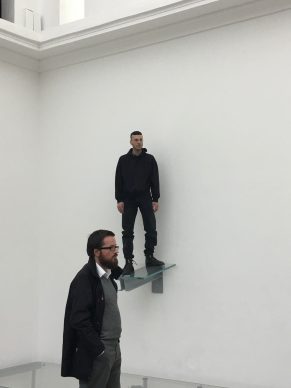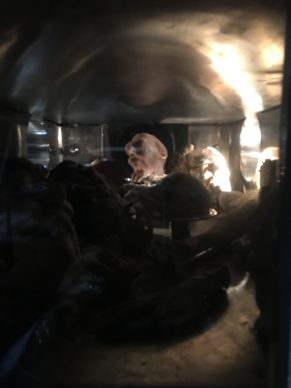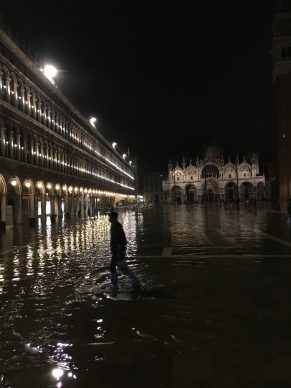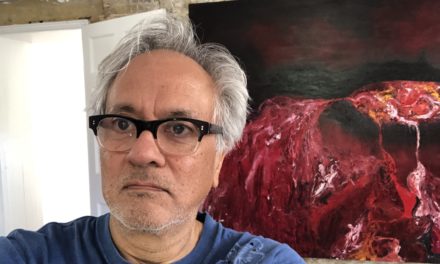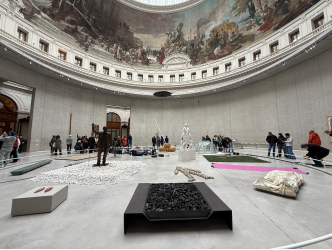With 900 works at the international pavilion curated by France’s Christine Macel plus 88 national pavilions spread across the entire city and all the collateral events, there’s a risk of visual overdose, boredom and exhaustion, but also genuine surprise.
This year it’s the international pavilion where the biggest surprises are to be found.
In the Arsenale you can spend time in the company of the attractive Berlin-based Polish artist Alicja Kwade’s (born 1979) spaces.
Her objective is for viewers to lose their bearings. This she achieves through mirror games placed ingeniously around one of the rooms of the Serenissima’s old naval base. Her lesson here, as it is so often, is that appearances can be deceptive. Patrizia Sandretto Re Rebaudengo, the famous Turin collector ( and head of the Fondazione Sandretto Re Rebaudengo) who knows her well, explains why she believes Alicja is highly relevant.
At the Venice Biennale preview, conversations in the narrow streets are always peppered with ‘Have you seen so-and-so?’, ‘What did you like?’, and ‘When are you going back?’
And in unison this year, everyone replied: ‘I loooved the German pavilion.’
I was the only dissonant note in this chorus of praise for Anne Imhof (born 1978) whose work I was already given the opportunity to dislike at the Hamburger Bahnof in Berlin last September.
‘Faust’ is a disappointment that drags on for four hours like an interminable opera, however it has just won the Golden Lion.
In an immense, beautiful glass cage which reveals the transparent basement below containing signs of human life (spoons, bottles of liquid, fabrics, electronic and electric equipment), you see youngsters with inexpressive faces strike poses or move in sync. The general impression is of a society that has forsaken its youth. They’re tall, beautiful and burdened. The atmosphere is akin to a group of punks and their dog loitering on a street corner.
Nothing more.
Mark Bradford (born 1961) is representing the US this year. I interviewed the artist after he’d already spoken at length about his project prior to it opening. He is extremely charismatic. And generous too. In every city where he works, he organises a philanthropic project. In Venice it’s an initiative with prisoners. Mark Bradford also makes seductive objects – paintings with beautiful colours and beautiful materials.
But the work is more complex than this. The huge foreboding ball that fills the first room is there to be oppressive. One is tempted to make the connection with the political situation in the US, but the pavilion builds towards a more optimistic note. Mark Bradford does not have any desire to make something truly new however, and it shows.
He explains:
Xavier Veilhan (born 1963) occupies the French pavilion. He’s known for his sculpture, his new forms derived from 3D printing, and his interest in architecture.
His submission here is adventurous. It is completely non-commercial and is entirely devoted to music. Together with the curators of the pavilion, the much-admired artist Christian Marclay (born 1955) and the director of Mamco in Geneva,Lionel Bovier, Veilhan has assembled a list of 120 musicians spanning all kinds of genres who will come and record music of their choosing during the Biennale’s seven-month run.
The visitor is invited to share in the recording process, which is normally inaccessible to the general public.
The recording studio, built from geometric wooden shapes, is stunning and beautiful.
And exceptionally for a biennale, the project will travel to Lisbon and Buenos Aires.
The project is lavish, the setting is aesthetically accomplished but the idea of the exhibition, more sonic than visual, leaves a lingering dissatisfaction.
We could mention the Russian pavilion and its courageous eagle casting its shadow over toy soldiers by Grisha Bruskin (born 1945).
We could mention the Iraqi pavilion with paintings depicting the ghosts of soldiers by the extraordinary Francis Alÿs (Belgian born 1959) who is lending his fame to this country’s pavilion in a bid to attract more people.
We could mention the best exhibition in Venice at the moment, the Philip Guston (1913-1980) solo show, and its relation to poetry (expect a full report in due course).
We could also mention the Italian pavilion where Roberto Cuoghi (born 1973), in a black and grandiose atmosphere, blends images of Catholicism and statuary, the idea of incarnation, reincarnation and visual representation.
It’s a way of saying the artist is God. Occasionally, but alas too often he is merely a small god, as the 2017 crop of the Venice Biennale, with its all too prevalent sense of déjà vu, demonstrates.
And sometimes the artist is a God.
And, at the end of the day the thing that is most striking about this 2017 edition of the Biennale is the social concern displayed by the artists.
In Venice, as always, there’s a place for all emotions, from swooning to boredom.
Here you can find the awards of the 57th Biennale.
Support independent news on art.
Your contribution : Make a monthly commitment to support JB Reports or a one off contribution as and when you feel like it. Choose the option that suits you best.
Need to cancel a recurring donation? Please go here.
The donation is considered to be a subscription for a fee set by the donor and for a duration also set by the donor.





